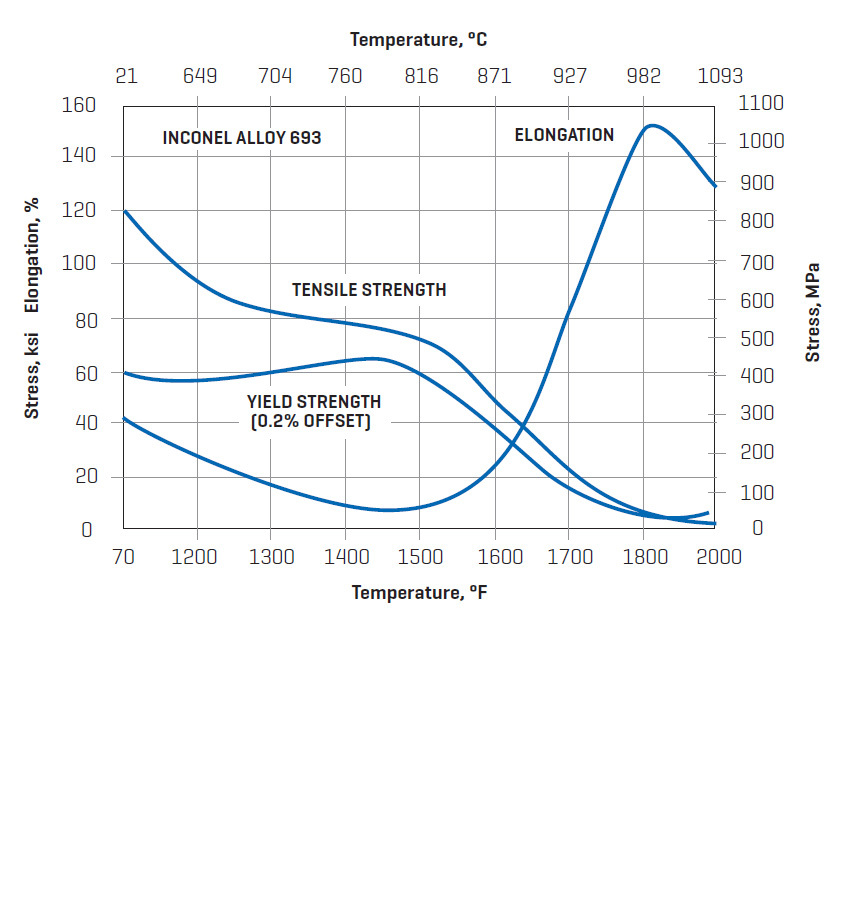Product Description
A nickel-chromium-aluminum alloy offering the best resistance to metal dusting of any available conventional alloy. Alloy 693 also offers exceptional resistance to oxidation and carburization at temperatures up to 2100°F (1150°C) with excursions to even higher temperatures. The alloy’s ability to resist metal dusting is especially useful in systems used to reform hydrogen and generate synthesis gas for various industries, including gas and liquid fuel production. Alloy 693 is protected by U.S. Patent Number 4,882,125.
STANDARD PRODUCT FORMS
Plate, sheet, strip, bar, seamless tubes and pipes.
MAJOR SPECIFICATIONS
UNS N06693
ASTM B 166, B 167, B 168
ASME SB 166, SB 167, SB 168
ASTM B 166, B 167, B 168
ASME SB 166, SB 167, SB 168
LIMITING CHEMICAL COMPOSITION, %
Ni..... Remaindera
Cr...... 27.0 – 31.0
Fe..............2.5-6.0
Al...............2.5-4.0
Nb.............0.5-2.5
Mn.......... 1.0 max.
Ti............ 1.0 max.
Cu........0.50 max.
Si..........0.50 max.
C...........0.15 max.
S........ 0.015 max.
aElement determined arithmetically by difference.
Cr...... 27.0 – 31.0
Fe..............2.5-6.0
Al...............2.5-4.0
Nb.............0.5-2.5
Mn.......... 1.0 max.
Ti............ 1.0 max.
Cu........0.50 max.
Si..........0.50 max.
C...........0.15 max.
S........ 0.015 max.
aElement determined arithmetically by difference.
PHYSICAL CONSTANTS AND THERMAL PROPERTIES
Density, Ib/in3.........................................................................0.280
g/cm3..........................................................................7.77
Melting Range, °F...................................................2403 – 2493
°C...................................................1317 – 1367
Specific Heat, Btu/lb•°F......................................................0.109
J/kg•°C............................................................ 455
Permeability at 200 Oersted.......................................... <1.005
Electrical ResistivityA, ohm•circ mil/ft............................... 702.7
Thermal ConductivityA, Btu•in/ft2•h•°F................................. 64.3
W/m•°C.................................................9.1
Coefficient of Expansion, 10-6 in/in•°F (μm/m•°C)
70-200°F (21–93°C)....................7.22 (13.04)
Young’s ModulusA, 103 psi.................................................... 28.5
GPa........................................................... 197
Shear ModulusA, 103 psi........................................................ 11.0
GPa..................................................................76
Poisson’s RatioA....................................................................... 0.30
ARoom temperature, as aged.
g/cm3..........................................................................7.77
Melting Range, °F...................................................2403 – 2493
°C...................................................1317 – 1367
Specific Heat, Btu/lb•°F......................................................0.109
J/kg•°C............................................................ 455
Permeability at 200 Oersted.......................................... <1.005
Electrical ResistivityA, ohm•circ mil/ft............................... 702.7
Thermal ConductivityA, Btu•in/ft2•h•°F................................. 64.3
W/m•°C.................................................9.1
Coefficient of Expansion, 10-6 in/in•°F (μm/m•°C)
70-200°F (21–93°C)....................7.22 (13.04)
Young’s ModulusA, 103 psi.................................................... 28.5
GPa........................................................... 197
Shear ModulusA, 103 psi........................................................ 11.0
GPa..................................................................76
Poisson’s RatioA....................................................................... 0.30
ARoom temperature, as aged.
TYPICAL MECHANICAL PROPERTIES

previous
next
previous
next
Key words:
Related Products
Online message








